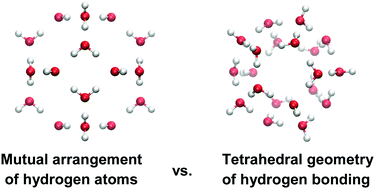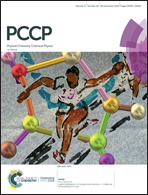Energetics of proton configurations in water polyhedra and hydrate frameworks: topology vs. geometry†
Abstract
The water frameworks of clathrate hydrates are characterized by a small deviation from tetrahedral geometry. The faces of the hydrate cages are most often pentagonal because the square and hexagonal faces produce appreciable strains on the hydrogen bonds. However, taking into account the specific arrangement of hydrogen atoms (protons) in the hydrogen bonds complicates the picture. The pentagonal rings are inferior to square and hexagonal rings in the number of stronger types of bonds corresponding to energetically more favorable mutual orientations of H-bonded molecules. The proton configurations with a large number of energetically preferable bonds can be computed during combinatorial optimization on the base of simplified topological models. A more accurate topological model for polyhedral water clusters allows us to find a class of proton configurations that are optimal in the number of energetically favorable H-bonds, taking into account the interaction between the second and third neighbors in the network. These topological models give preference to water polyhedra and clathrate hydrate structures without pentagonal faces. We show that the geometric stability factor (tetrahedrality) is decisive for proton-disordered systems. At that time, the topological factor (maximum number of preferred H-bond types) is often dominant when searching for the lowest-energy proton configurations. The energy minimization is carried out using different molecular interaction potentials and the Tinker molecular modeling package.



 Please wait while we load your content...
Please wait while we load your content...